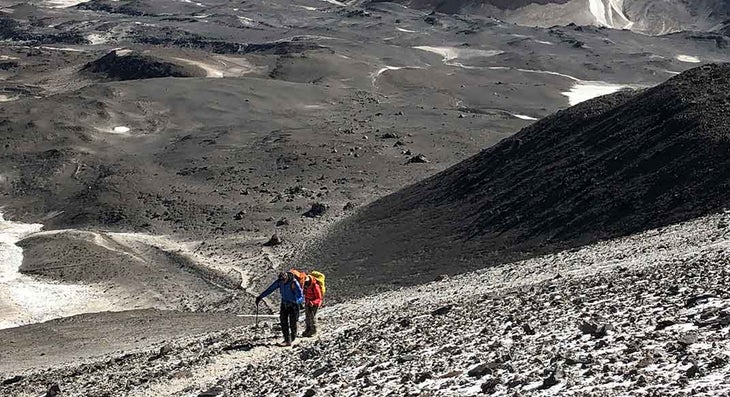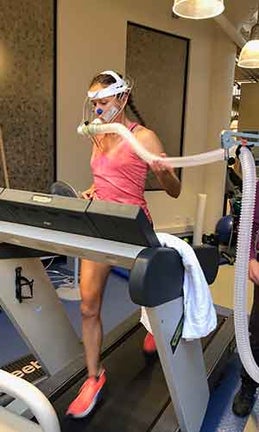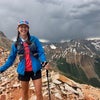New perk! Get after it with local recommendations just for you. Discover nearby events, routes out your door, and hidden gems when you sign up for the Local Running Drop.
On December 20, 2017, champion ultrarunner Magdalena Boulet and mountaineer Roxanne Vogel reached the 22,615-foot summit of Ojos del Salado, the world’s highest active volcano, located on the northern end of the Chile-Argentina border.
Vogel had summited above 20,000 feet several times, but Boulet—the 2015 Western States 100 champion and UltraRunner of the Year—had never been at an elevation above 18,000 feet.
“I remember feeling this relief of getting to the top, but only for a split second,” she says. “Then it hit me: ‘Wow, this is only half way, I still have to come off this mountain.’” Boulet, 44, spoke while drinking tea in the kitchen of her cottage-style home in Oakland, California, where she lives with her husband Richie and 12-year-old son Owen.
Boulet and Vogel’s expedition was part science experiment and part adventure, commissioned by Berkeley-based GU Energy Labs, where Boulet works as vice president of Innovation, Research and Development and Vogel works as a sports nutritionist.
Their goal: reach the top of the volcano in half the time of a typical expedition. Climbers normally take 10 or more days, camping below the peak prior to summiting, to acclimate. Boulet and Vogel wanted to summit in five.

Could sea-level athletes safely be ready to summit with far fewer days at a base camp? By documenting and testing all aspects of their preparation and expedition, Boulet and Vogel hope to develop a training and nutrition protocol to help other athletes embarking on extreme high-altitude challenges.
The duo’s plan combined six weeks of rigorous training with high-altitude simulation at their homes and workplace in the Bay Area, through the use of Hypoxico Altitude Training Systems tents and chambers, which simulate oxygen-depleted high elevation. They slept in a Hypoxico tent every night and spent time working in a hypoxic chamber set up in the Gu office during the day. The team also used the opportunity to test nutritional products under development at GU.
Boulet and Vogel often had twice-daily workouts, which included a great deal of uphill work—step-ups, stair repeats and hiking on a high-incline treadmill—with a weighted vest. They also performed plyometrics, upper-body conditioning and slow running or hiking with a heavy pack. Some of their exercising took place in the hypoxic chamber.
Ultimtately, Boulet and Vogel, along with guide and expert climber Blaine Horner, met their goal of summiting in the time frame they set. But Boulet says it marked the most difficult and humbling experience of her athletic career.
Trail Runner sat down with her to discuss the expedition and how her plans for competing in 2018 are taking shape.
On Day 5 of the trip, you were at a base camp around 17,000 feet and had to go up about 5,600 feet, over approximately six miles, to reach the summit. What was the most challenging part of that ascent?
I made a rookie mistake of not breaking in my mountaineering boots. Mountaineering is definitely a new adventure for me, so I’m not as familiar with—and not as in love with—the amount of equipment that’s necessary.
I’d been hiking and doing great in my Hoka waterproof hiking boots, and I was trying to convince the others at camp that I should use them. At the last minute they told me that if I want to keep my toes, I should use the mountaineering boots, which I still kind of disagree with.
I used my Hoka boots all the way until 19,000 feet, and I carried my mountaineering boots in my pack. At a refugio, I made the switch. We had a really good pace up to that point, but [after I switched boots] I started moving slower than my two teammates, who were experienced mountaineers. I was wasting a lot of energy, slipping more. I started focusing all my energy on just walking properly. The higher we went, the slower the pace became. In addition to my pace slowing down, everything around me started to slow down. I could hear conversations around me at a slow pace.
Did you draw on past experiences at ultras to help you cope?
Absolutely. There were so many parallels to things not going perfect on race day, and being able to react in the right way.
I started to doubt whether I could do this, and there were times when my teammates were probably questioning whether I should continue. We would stop and check on each other, and they’d ask me questions. My answer every time was, “I want to keep going.” But if I were alone on that mountain, I would have turned around.
I had to dig into my bag of tools to turn doubt around, and [focused on] moving one foot in front of the other, and trying to relax a bit. Our original plan was to take 12 to 14 hours round trip [to get to the summit and back to base camp, about 12 miles]. But by the time we reached 20,000 feet, we were already a couple of hours behind. We reached the summit in 12 hours, so we were about four hours behind schedule.

Aside from breaking in your boots, is there anything else you would have done differently?
Yes, another mistake I would have corrected is access to food. As an ultrarunner, I practice with a hydration vest, so I have access to food and hydration at any given time. I also practice eating and drinking frequently. On the mountain, carrying so much equipment and gear, my fuel was in a backpack. The protocol was that we’d hike for an hour, then we’d stop to eat and drink. Then we’d continue. Moving for an hour, then stopping to fuel, didn’t work well for me. I should have had a hydration vest or something to provide easy access to fuel, so I could’ve taken it while I was moving; or, I should have practiced eating and drinking on the hour in training. My backpack didn’t even have side pockets; it was all enclosed, and the idea of stopping to take off all of that gear was really overwhelming. I could tell I needed more fuel, but the higher we got, the more my appetite was suppressed.
The final stretch to the summit features massive boulders and technical climbing. How was the transition from hiking to climbing?
Mentally, I was unprepared for that part. I knew from reading about the route that there would be ropes involved, but in my head I was thinking about the [fixed] Half Dome ropes – “I’ll just hang onto some ropes!” But this was full-on climbing, and we had to get roped in. Luckily, I was with an experienced team. According to them, I did really well. But with the level of tension and fear I felt, I wouldn’t say I did that well. In in my head I was thinking, “Wow, we still need to come back down this rocky part.”
What was the summit moment like?
I felt my cognitive response was slower, and I was under-fueled. I ate, but things were not going down easily. It was windy and about negative 10 to 12 Celsius (14 to 10 degrees Farenheit). But we got lucky. The day before, it snowed on a French team that summited; they had no views.
I keep saying to everyone, “I went to Mars and back.” It is the most remote part of the world. I didn’t really believe until I saw it. There’s just nothing for miles and miles [except for] 20,000-foot-plus peaks.
How did you handle getting down?
I definitely moved slowly and not in a straight line. That’s when it was evident to me that I didn’t have control of my lower body or legs. If it were not for gravity, I’m not sure I would have been moving. I’d gain some momentum, and anytime there was a turn, my legs would collapse and I’d fall to the ground. Roxanne was in front of me, and I’d brake on her to go in the right direction. That happened until about 19,000 feet, where we went into the refugio and I switched my shoes. Once I did that, I was cruising. But I could tell there was nothing left in my legs.
What advice do you have for other athletes facing high-altitude challenges?
Know the toll that exercise is going to have on your body, and make sure you provide yourself [enough fuel]. Make your food choices as efficient as possible, and have easy access to them, because of how strenuous simple tasks become at high altitude. Also, be aware of how much you’re eating or not eating.
What advice can you offer for handling travel fatigue before a big ascent like this?
You have to go in with the right attitude. I was prepared that this was going to be intense travel. You’ve got to have the right playlist and the right snacks; make sure you have snacks in case there’s no access to good food along the way. Make sure everyone on your team is on the same page, because if you have one person complaining, it brings the energy down.
In hindsight, do you think your training was effective?
Our training protocol definitely worked. Initial body-composition and bone-density tests showed muscular imbalance for both of us. [After] our six-week training block, which was pretty strenuous, the results showed that we had exchanged five pounds of fat with five pounds of muscle and increased our bone density without changing body weight.
You’re a fast runner. What did you like—or not like—about this strenuous, slow high-altitude hiking?
I loved it. I absolutely loved the challenge and the problem solving. It’s not that different from setting out to do a 100-mile race. It took me 18 hours, almost as long as doing Western States. I definitely see this as an ultra-endurance event, despite moving so slowly.
What are your racing plans for 2018?
I would like to go back to UTMB. I’ve decided not to do Western States, and I am struggling with giving it up. I wanted to pick one or the other, because I don’t think doing both is conducive to a great performance. I’ve looked at Marathon des Sables, Mt. Fuji, and at a new race by UTMB in a very remote part of China on the border with the Himalayan mountains; but, they’re all coming up really quickly, and I still have not committed to any of them. I might do the Mont Blanc Marathon as a preparation for UTMB.
What did you learn about yourself through this summit experience?
I was brought down to my knees. I didn’t think I’d ever have such a humbling experience in any athletic endeavor. I’m just tapping into this sport of mountaineering. I absorbed a lot in a short period of time, but a lot I need to practice. You can’t replace experience.
This interview was edited for length. To see more of Boulet’s photos from her expedition, and to read her descriptions of each day of the journey, see her Instagram posts @RunBoulet.
Sarah Lavender Smith is a contributing editor for Trail Runner and author of The Trail Runner’s Companion: A Step-by-Step Guide to Trail Running and Racing, from 5Ks to Ultras.
